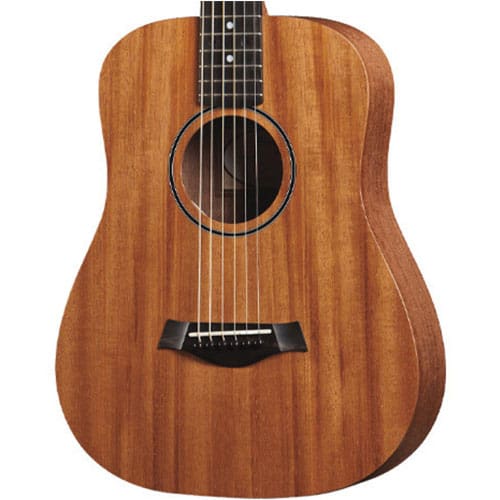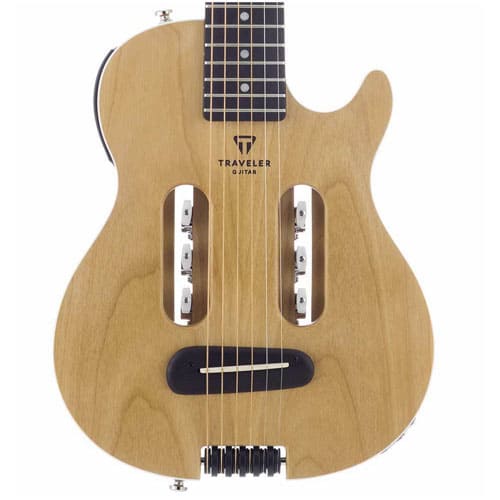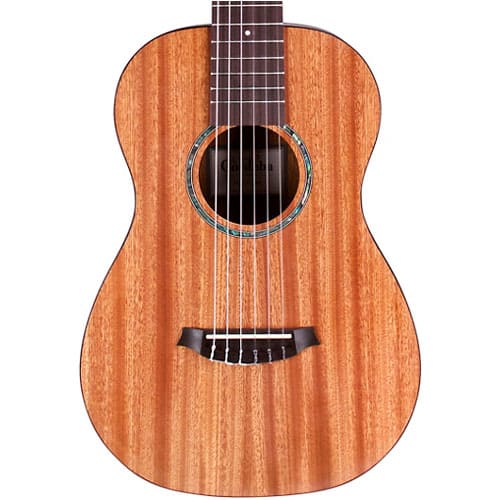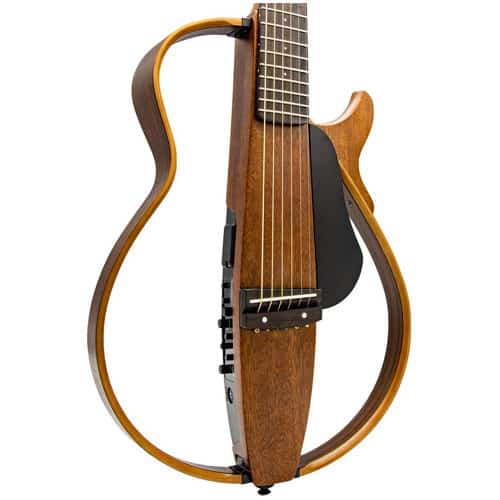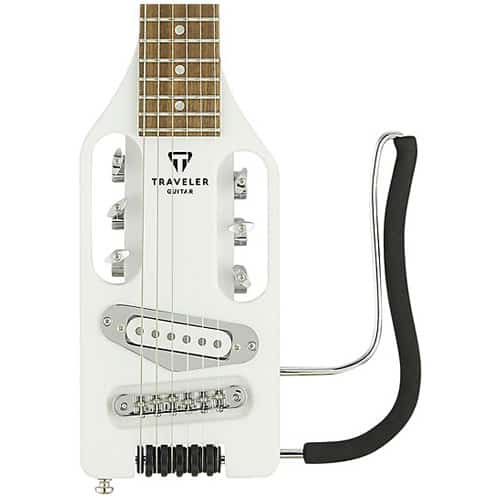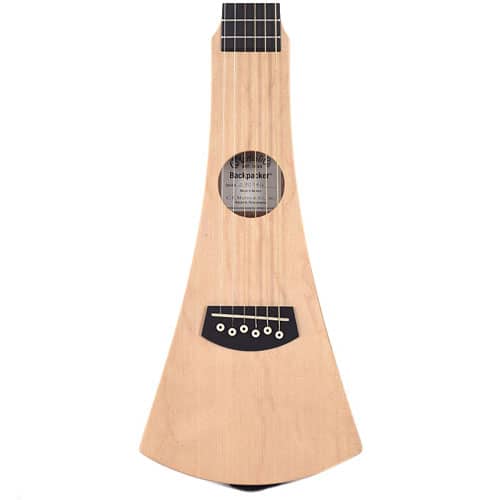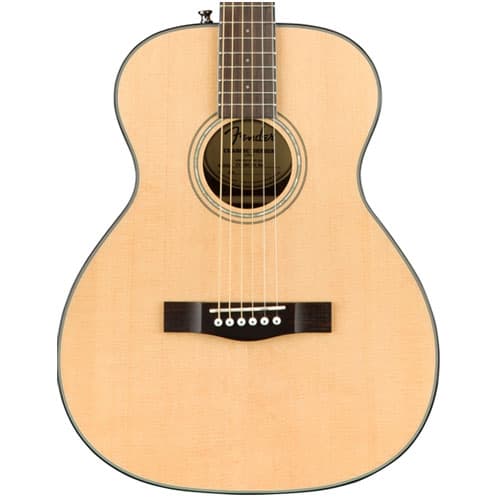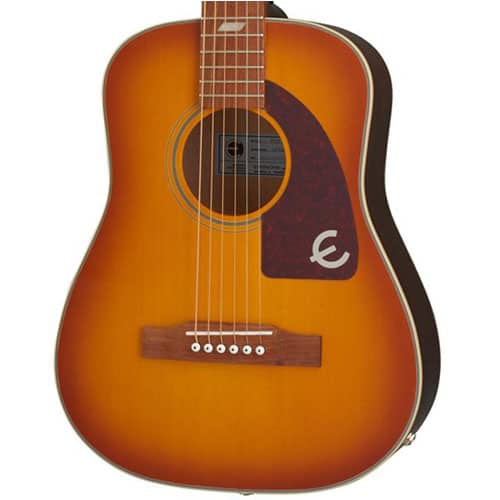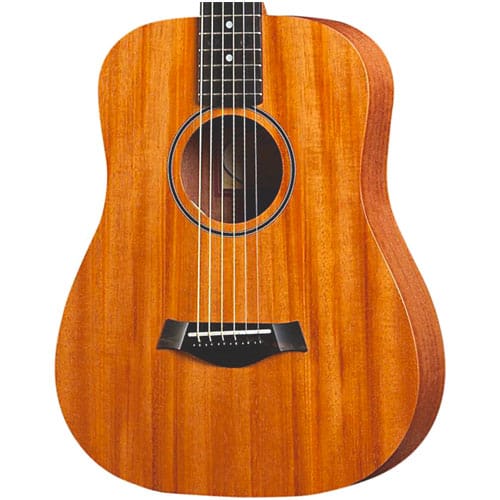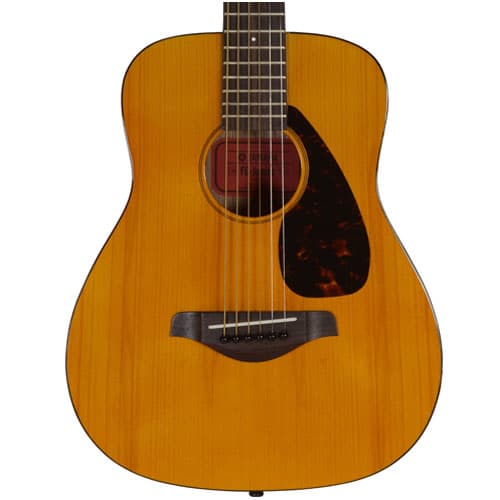Table of Contents
If your guitar is one of your prized possessions, you may not want to risk lugging it around with you when you travel. Yet going without playing isn’t an attractive option either. What to do?
If you often find yourself in this predicament, a travel guitar is a great compromise. Not only can you stay up-to-date on your skills, you can do so without risking your favorite instrument.
With so many models to choose from, however, picking the best travel model is no easy feat. That’s where we come in.
After much consideration, we’ve picked the Taylor BT2 as the best guitar for travel on the market today. Its solid mahogany top sounds fantastic yet its layered sapele frame is durable enough to withstand even the busiest travel schedule.
The BT2 is not your only option, however. The best travel guitars come in different shapes and sizes and we’ve rated nine other guitars as some of the top options out there.
The 10 Best Travel Guitars:
| Image | Travel Guitars | Summary | Check Price |
|---|---|---|---|
 | Taylor BT2 Baby Taylor Acoustic Guitar | Best Choice: Classic body shape and outstanding tonewoods to excel on stage, in the studio or on the road | Check price |
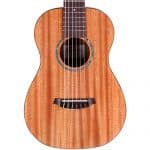 | Cordoba Mini II MH Travel Guitar | Best Value: Buttery nylon-string tone and easy playability for guitarists on a tight budget | Check price |
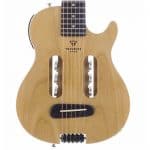 | Traveler Escape MK-III Travel Guitar | Premium Pick: Top-notch build quality with a full scale neck condensed into a travel-friendly package | Check price |
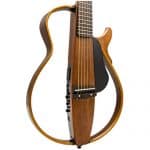 | Yamaha SLG200S Silent Guitar | Minimalist Acoustic-Electric: Modern acoustic-electric tones housed in a beautiful, sleek frame | Check price |
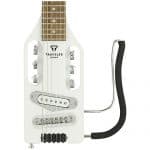 | Traveler Ultra-Light Electric Travel Guitar | Full-Toned Portable Electric: Tiny electric traveler guitar that preserves standard scale length and playability | Check price |
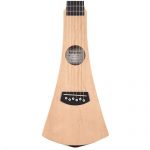 | Martin Backpacker Steel String Travel Guitar | Perfect Practice Companion: Eye-catching shape with solid wood tones and great playability | Check price |
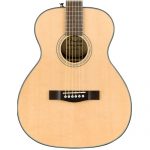 | Fender CT140-SE | Solid Spruce Top on a Budget: Solid top with scalloped bracing performs like models well above its class | Check price |
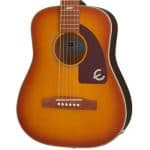 | Epiphone Lil’ Tex Acoustic Travel Guitar | Mini Shortscale Travel Acoustic: Extra-short scale guitar that captures plenty of Epiphone’s vintage flair | Check price |
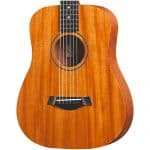 | Martin LXK2 Little Martin | Unique Tonewood Design: Unique HPL frame for extra durability, with beautiful appearance of koa | Check price |
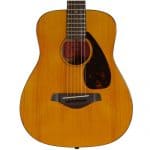 | Yamaha JR1 Mini Folk Guitar | Budget Friendly 3/4 Size: Affordable 3/4-scale dreadnought that combines Yamaha’s famous durability with a balanced tonal profile | Check price |
Taylor BT2 Baby Taylor Acoustic Guitar
If you’re looking for one of the best travel acoustics that can hold its own in the studio, the practice room or tour bus, you can’t go wrong with the BT2 Baby Taylor.
This acoustic guitar from Taylor offers excellent sound quality and durability. What more could you ask for in a travel guitar?
The BT2 uses a solid mahogany top with a layered sapele back and sides and provides Taylor’s clear, chiming trebles, as well as a sharp mid-range response.
Sapele is a great choice for a travel-sized guitar because it’s sturdy but still supplies a bright, balanced sound.
Some guitars sacrifice tone for comfort. Not the BT2. The 3/4-size dreadnought body is easy to play and hold yet still offers some of the best tonal variety available in a guitar this size. If you love the booming bass and powerful mid-range of a full-size dreadnought, you’ll find a lot to love here.
The 22.75-inch scale length, meanwhile, lends a slinky and compact feel to the mahogany neck and ebony fretboard.
The full package includes a baby Taylor gig bag with backpack straps, so you can easily carry the BT2 wherever you go.
Positives
- Clear, bright tonal profile makes this the best travel guitar for songwriting and recording
- Mahogany top and sapele back and sides provide great resonance and tonal depth
Negatives
- Plain appearance compared to other travel guitars in its price range
- 22.75-inch scale may feel cramped for players used to a full-size guitar

Cordoba Mini II MH Travel Guitar
The Cordoba Mini II MH captures the smooth, mellow sound of a classical guitar in a handy travel size.
It’s a fantastic package for nylon-string guitar players, but the unbeatable value makes it perfect for guitarists on a tighter budget as well.
This travel guitar offers a full mahogany body, with a C-shape mahogany neck and composite fingerboard.
The fan bracing underneath the top preserves all the articulation and warmth of full-scale classical guitars, while the layered wood construction keeps the body sleek and durable.
At the other end of the neck, you’ll find a nut measuring 1.78 inches. While it’s wider than most steel-string guitars, it’s comfortable enough to suit both lifelong classical guitar players and those who’ve never touched a nylon-string guitar.
Sonically, the mahogany delivers smooth warmth with a slight emphasis on the mid-range. It’s a great counterpoint to the brash attack of tonewoods like spruce and it’s versatile enough for rhythm, leads and accents.
Positives
- Best travel guitar for capturing the warm, glassy vibe of a classical acoustic
- Mahogany body and fan bracing offer authentic tones with modern durability
Negatives
- Doesn’t project as well as steel-string or electric travel guitars
- Wider neck is comfortable for most acoustic players, but might be too thick for some electric guitarists

Traveler Escape MK-III Travel Guitar
Traveler is the top brand in the travel guitar market, and for good reason: the company’s Escape series has redefined just how good a travel guitar can look and sound.
The latest model, the Escape MK-III, offers refined updates while staying true to the popular design.
Unlike most other travel guitars, the Escape offers a full 25.5-inch scale length in a 29.5-inch frame.
This keeps the guitar just as compact as other offerings, but gives it the same playability and feel as a full-size guitar underneath your fingers. That alone makes this Traveler guitar an amazing option for those with a bigger budget.
Rather than sitting at the end of the neck, the tuning pegs are slotted inside the body. As well as saving space, this makes it easy to keep your strings in tune without needing to reach at all.
If you’re near an amp, you can plug the Escape in for a tone that’s closer to an acoustic electric guitar. It’s got plenty of snap, but the acoustic strings mellow it out for a more traditional strumming sound. If you’re on-the-go, you can also play straight through the onboard headphone amp with its built-in tuner and EQ.
Positives
- Onboard headphone amp lets you dial in the perfect tone with effects built-in
- Innovative design provides a full 25.5-inch scale in a compact frame
Negatives
- Doesn’t project as well as acoustic travel guitars when not plugged in
- It costs more than other travel guitars and short-scale electric guitars

Yamaha SLG200S Silent Guitar
Yamaha’s SLG200S Silent Guitar offers a sleek minimalist frame that’s sure to turn heads. This guitar offers a lot more than stunning looks, however.
It also provides one of the best acoustic electric guitar sounds on the market. Combined with the collapsible frame, it’s a great pick for discerning players who need a refined feel and tone in a travel guitar.
The SLG200S offers a mahogany body and rosewood and maple frame. It’s artfully curved, with a central block and wooden pickguard to add heft and visual appeal.
But while the “body-less” frame might seem ultra modern, this traveler guitar also incorporates a few time-honored touches.
The neck measures 1 11/16 inches at the nut, for a compact vintage feel while the rosewood fretboard brings back memories of the classic acoustic guitars of the 1960s.
The onboard preamp and pickup lets you plug in or play directly through a headphone output. Along with classic controls for volume and EQ, you can also dial in effects like reverb and chorus.
The SLG200S also prevents feedback better than most of its peers. Without a soundhole, this travel guitar performs more like an electric guitar and sounds just as great on stage as it does on a quiet tour bus.
Positives
- Eye-catching looks thanks to curved wooden frame and sleek shape
- Onboard pickup and preamp offers plenty of effects to pair with your base tone
Negatives
- Larger and bulkier than some other travel guitars
- Delicate wooden frame isn’t as durable as some more affordable travel instruments

Traveler Ultra-Light Electric Travel Guitar
If you need the smallest and lightest traveler guitar available, the Ultra-Light Electric axe is one of your best options.
At less than 2.5 feet long and weighing in around three pounds, it packs a full-length neck and scale into a package that’s smaller than most other short-scale traveler guitar models.
The center block and neck are made with American maple, while the fretboard is black walnut for a sleek, refined look. Instead of a headstock (this is a headless guitar), the tuners fit inside the frame to save space without sacrificing scale length.
Near the bridge, you’ll find a humbucker to provide your electric tones.
You can plug into a standard amplifier via the 1/4-inch jack, or go straight to a headphone amp or digital console.
Finally, the Ultra-Light also includes a detachable chrome bar. Not only does it make it easier to balance the guitar in your lap, it snaps off so you can save space whenever you’re not strumming chords.
Positives
- Incredibly small and lightweight frame is the best design for frequent travelers
- Included gig bag makes it easy to take protect guitar from damage
Negatives
- No onboard controls to adjust tone of built-in pickup
- Chrome lap rest bar might feel awkward or uncomfortable for some players

Martin Backpacker Steel String Travel Guitar
Martin is a brand known for its classic body shapes, but the Backpacker travel guitar bucks that trend.
With an unorthodox fan shape and sleek, stripped-back frame, it’s one of the most compact acoustic guitars on our list. The slim shape and comfortable neck make it perfect for strumming at a campfire or using as a practice instrument.
The Backpacker uses a solid spruce top along with solid wood for the back and sides. The fretboard is Richlite, which provides an even playing surface and captures a smooth and balanced response from the 15 frets.
For such a small body, the Backpacker projects surprisingly well. It’s brighter and more focused in the trebles, with a warm, loose bass.
The low end offers a resonant character that shares some characteristics with a washtub bass. It’s perfect for balancing out the clarity in the upper registers and it gives the Backpacker a very unique voice compared to other travel guitars.
Positives
- It’s one of the best travel guitars for carrying on your back, thanks to its compact frame
- Solid spruce top and solid wood sides provide outstanding projection and acoustic resonance
Negatives
- Only 15 frets, which limits your potential for upper-register creativity
- Unorthodox fan shape isn’t comfortable to play when seated

Fender CT140-SE
Fender is known for its electric guitars, but you can also get a great deal on the company’s acoustic travel guitars. The CT140-SE builds on a unique shape and scale length for a distinctive playing experience.
Most other travel guitars take the shape of a dreadnought, or opt for a unique body style to minimize space. The CT140-SE, however, employs an auditorium body with a shortened 23.5-inch scale.
Compared to other travel guitars, the auditorium size is focused and articulate with a bit less rumble yet more touch throughout the low-end. This model uses a solid spruce top with scalloped bracing, so you get even more sustain and resonance from the wood.
The rosewood body and mahogany neck are warm and mellow, which is a nice counterpoint to the bright, sharper tone of solid spruce. The shorter scale length and rosewood fingerboard also give the guitar a smoother feel than full-size competitors.
Whether you enjoy fingerstyle guitar or just want a more responsive instrument, that smoothness is a major advantage. The CT140-SE also offers an onboard Fishman preamp so you can dial in the perfect acoustic tone on stage or in the studio.
Positives
- One of the best travel guitars for fingerstyle playing thanks to the concert body
- Fishman preamp helps you dial in the perfect tone on stage
Negatives
- Concert frame doesn’t have the power and low-end boom of a dreadnought shape
- Some users report fret buzz out of the box and a need for professional setup to fix it

Epiphone Lil’ Tex Acoustic Travel Guitar
Epiphone’s lineup of acoustic guitars offers versatile models with storied histories from the brand’s heritage.
The new Lil’ Tex draws on that heritage to make a short-scale travel acoustic that’s still unmistakably Epiphone in both tone and feel.
The Lil’ Tex uses a solid spruce top with a sapele body and mahogany neck. Sapele is similar to mahogany, with a slightly brighter and more balanced finish. It perfectly captures the smooth, vibrant sound of vintage acoustic guitars while also offering a punchy modern response.
The scale measures just 22.68 inches, which makes it easy to carry by hand or throw in a trunk for practices, jam sessions or outdoor performances.
New guitar players and children might also find the shorter scale useful, because it makes it easier to fret chords with small hands.
The faded cherry finish is another plus. It sits between sunburst and tea burst, offering a warm hue that’s distinctive yet refined.
Positives
- Faded cherry finish captures vintage Epiphone character with plenty of flair
- Extra-short scale is perfect for young beginners who need a more comfortable neck and body size
Negatives
- Small body and scale make it tough for larger players to access upper frets
- Included gig bag doesn’t offer a lot of padding to protect against drops or damage

Martin LXK2 Little Martin
With more than 150 years of history, Martin is one of the most famous acoustic guitar brands in the world.
But despite its storied heritage, the company continues to innovate with affordable models like the LXK2 Little Martin.
This guitar is made with high-pressure laminate (HPL), a durable material that’s resistant to dings and changes in temperature and pressure.
While many travel guitars might warp or go out of tune on the road, the LXK2 is built to deliver the same tone in any situation.
To keep it comfortable, the LXK2 uses an auditorium body modeled after Martin’s “0” lineup.
The scale length measures 23 inches, with a 1 11/16 width at the nut. While shorter than full-scale guitars, the measurements are close enough to offer a seamless transition from the travel guitar.
Sonically, this travel acoustic guitar provides a buttery response that’s remarkably balanced across the tonal range. It doesn’t lend significant accents to treble, mids, or bass, which helps it sit comfortably on its own and in stage mixes.
Positives
- Laminate body gives the guitar a consistent, dependable voice that fits well in all situations
- Small auditorium body style provides low-end depth while retaining focus and articulation
Negatives
- High-pressure laminate body isn’t as dynamic as guitars made with solid wood
- Balanced tonal response can feel a bit bland to players who want a distinctive guitar

Yamaha JR1 Mini Folk Guitar
Yamaha’s JR1 condenses the power and articulation of the company’s dreadnoughts into a three-quarter size that’s perfect for travel and practice. If you’re looking for a versatile and durable travel guitar on a tight budget, the JR1 is tough to beat.
This guitar has a spruce top with meranti back and sides. It’s built for strummers and new guitar players who want a versatile tonal profile. The nato neck and Javanese rosewood fretboard are clean and comfortable, while the 21 1/4-inch scale length is significantly shorter than a full-scale neck.
The dreadnought shape provides plenty of bass and mid-range, with warmer trebles that don’t overpower the other frequencies.
Because the neck is so much shorter, it’s a good guitar for young beginners. The tighter distance between the frets makes it easier to grab chords and single notes, while the compact frame is comfortable whether sitting down or standing up.
Positives
- Spruce top and meranti back and sides provide balanced tonal profile that can fit in any genre
- Shorter scale length is perfect for young players who need less distance between the frets
Negatives
- All-laminate construction doesn’t resonate as well as a travel guitar made with solid wood
- 21 1/4-inch scale length is a bit cramped for guitar players used to a full-size acoustic guitar

Are Travel Guitars Worth It?
Some players see travel guitars as an essential tool for keeping their skills sharp when they’re on the road. There are other players, however, that view travel guitars as a poor replacement for their full-scale axe. So, are they worth it?
The Pros:
A travel guitar is an easy way to stay in the groove whether you’re a globetrotter, are on a one-week vacation or travel frequently for work. It’s a great tool to practice skills like songwriting, improvisation and rhythm playing — and you don’t need to worry about damaging your favorite full-scale guitar.
Lots of touring pros love travel guitars, because they’re smooth and easy to play when you’re away from your favorite full-size instruments. Even if you’re not always on the road, you can still take advantage of a travel guitar. Their small frame makes them great for younger, smaller players.
If you struggle to fit your hands around a normal neck, or if you want a more compact feel between the frets, a travel-sized guitar could be a good option for you.
The Cons:
When at home, there aren’t many players who would reach for their travel guitar in favor of their full-scale axe.
Built for portability and durability, many travel acoustic guitars just can’t live up to the sound a traditional model can offer.
Certain styles of music can also be difficult on a travel guitar, thanks to their shorter scales and fewer frets. This can be frustrating for players who want to reach as high as their axe can go, or for lead players who enjoy playing lines high on the neck.
So, unless you’re on the road a lot and need something easy to transport, your travel guitar might not get much use.
Are Travel Guitars Easier to Play?
While most players use travel guitars when they’re out of the house, some guitarists do choose to jam with them at home, simply because they’re so easy to play.
The shorter scale and smaller body size of the best travel guitars make them perfect for beginners and smaller players who need a more comfortable instrument to play with. If you just want more compact frets and a more comfortable frame, you might also find a travel guitar easier to play.
There are some playability issues, however. The fretboard can be a problem for some players because a guitar for travel has only 15-17 frets instead of the usual 18-20.
The shorter scale length can also make it harder to fret notes at the very top of the scale. If you like to perform acrobatic lines and play chiming licks high on the neck of your guitar, you might struggle with a guitar built for traveling.
If you need a guitar created for playability, be sure to check out our articles on acoustic guitars with thin necks and guitars with low action. These instruments are built to be as easy to play as possible, and they’re perfect for guitar players of every age and size.
Travel Guitars vs. Parlor Guitars
Parlor guitars are another small-body acoustic guitar shape. While they share some similarities, there are also a few key distinctions between the two.
Parlor guitars offer a smaller, thinner body style than acoustic guitar shapes like dreadnoughts or concert models. The bouts are more symmetrical, with some parlor guitars looking almost peanut-shaped.
That body style creates a brash, lo-fi tone with a strong emphasis on the mid-range. The unique sonic signature makes parlor guitars popular in genres like blues, folk and country. If you love to play these genres, then a parlor style might make a perfect traveling guitar for you.
A proper travel guitar is often designed with a different sound in mind. Many of the best travel guitars take larger body styles and shrink them down to 3/4 size or smaller, so you get the same balanced acoustic response, but in a smaller package.
If you want that broad sonic signature in a compact frame, a travel guitar is one of the best solutions. You can also find some electric guitar models in a travel size, which is a good alternative if you prefer to play plugged in. Parlor guitars, on the other hand, only come in acoustic versions.
If you want to learn more about the unique features this style of guitar offers, check out our article on the best parlor guitars. Whether you’re an avid blues player or you’ve never touched a parlor guitar before, you’re sure to find a great model for your needs.
Bottom Line
Its versatility makes the Taylor BT2 our pick for the best travel guitar. It’s perfect for all types of musicians, from studio artists to touring players to hobbyists who want an easy guitar to pick up and play.
If you want a more compact electric guitar, you might want to try out the Traveler Escape Mk III or Traveler Ultra-Light instead. You can also take a look at the Cordoba Mini II MH for outstanding classical guitar tones in a travel-sized package.
Do you use a travel guitar for playing on the road? Are there other models that you think should have made our best travel guitars list? Let us know in the comments below.
